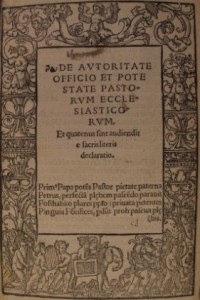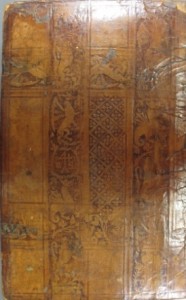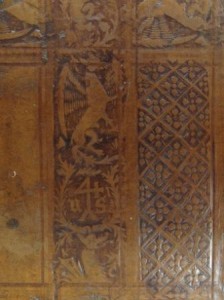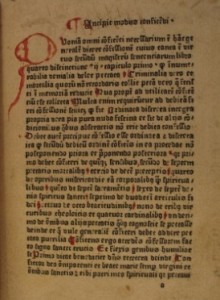Recent acquisitions from the Mendham sale

Title page of the first item in the Spierinck binding – De autoritate officio et potestate pastorum ecclesiasticorum [Zwolle : Simon Corver, 1522?], classmark 5000.c.63
In June, despite much protest from historians, academics and librarians, a significant portion of the Mendham Collection in Canterbury – which had been publicly accessible for almost 150 years – was sold. Assembled by Joseph Mendham (1769‐1856), a Church of England priest and controversialist, it consisted of around 5000 volumes concerning evangelical Protestantism, Catholicism and anti-Catholicism. It was particularly strong in early printed books, containing 77 incunabula and over 750 sixteenth-century books, all of which had been on loan from the Law Society to the University of Kent and Canterbury Cathedral Library since 1984. Although many lots will have gone to private collectors, some have been purchased by institutional libraries, and Cambridge University Library successfully acquired two volumes, containing six imprints.
The sale comprised 142 lots of manuscripts, incunabula and other early printed books, of which 36 did not sell (though some were purchased by institutions after the sale). The total amount raised was £1,180,875. The most expensive lot was an interleaved copy of Thomas Martin’s 1554 treatise on the marriage of priests, with extensive notes in the hand of John Ponet (Bishop of Winchester 1551-1553); as such, it forms what is essentially the manuscript of his reply, published in 1555. This item was bought by an American institutional library, but in October a temporary export bar was put in place by the Government, in the hope that it can be kept in this country. Lot 104, a Sarum Missal (Rouen: 1510) to which unique printed prayers for the phantom pregnancy of Queen Mary were added in the 1550s, sold for £86,500.
The two lots acquired by Cambridge University Library are a volume containing five rare works printed in the 1520s and bound in Cambridge shortly after by Nicholas Spierinck, and a unique Dutch incunable (Andreas de Escobar, Modus confitendi, Zwolle 1480-1481), which failed to sell at the auction, but was acquired afterwards.
The Cambridge binding, now with the classmark 5000.c.63, contains five works, three by the Dutch reformer Wessel Gansfort (1419-1489), one by the Mechelen-born Johannes Gochius (d. 1475) and one anonymous work on the authority of the church. None carries the name of their printer or the date on which they were printed, but (based on type and ornaments) all are believed to have been produced in Zwolle by Simon Corver, who worked there from 1519 until 1523. In this short period more than 40 works came from his press and it is largely thanks to him that Gansfort is remembered today. In 1523 Corver moved to Hamburg, where he printed sixteen works, of which eleven were authored by Luther. All five of the imprints in our volume are rare, though the University Library holds copies of three already. Both the anonymous work on church authority, De autoritate officio et potestate pastorum ecclesiasticorum [c. 1522], and Gochius’ In divine gratie [c. 1521] are known in the UK in only two copies (British Library and Cambridge University Library). The UK holdings of the three works by Gansfort are as follows:
1) De sacramento eucharistiae. Et audienda missa – British Library & Lambeth Palace (2 copies)
2) Epistola adversus M. Engelbertum Leydensem – British Library, Cambridge University Library (2 copies) and All Souls College Oxford
3) Farrago Wesseli – British Library and Lambeth Palace (2 copies)
The binding itself, although it has been given a new spine relatively recently, preserves the boards, decorated with roll tools showing dragons and lions, and the letters NS, for Nicholas Spierinck. It was once clasped, but the fittings have perished; tabs of vellum, possibly sixteenth-century, protrude from the fore-edge, marking the beginning of each work. There are sixteenth-century annotations in the margins, and notes by Mendham himself throughout; although many nineteenth-century collectors acquired early printed books, not many used and annotated them so extensively. Given that all the works were printed in Zwolle, it seems likely that they came to Cambridge together rather than being assembled by a scholar at the University from different sources. The three works in this volume already held by the University Library are also bound together (with one other work), in H*.11.13(D), which suggests that the works appeared individually in booksellers’ shops and were bought by and bound together for individual customers. Furthermore, H*.11.13(D) was owned by the controversialist William Charke, who matriculated at Peterhouse in 1560, so (although it’s now in an early seventeenth-century binding) that collection may have been assembled in Cambridge at the same time as the Mendham volume. Corver’s books probably came to England via a large centre such as Amsterdam, with which he had links through his family. The binder Nicholas Spierinck started out as a bookseller in Antwerp, and is known to have imported books from the continent to sell in Cambridge in the early years of the sixteenth century. Such a volume is a wonderful addition to the Library’s holdings, representing the growth of religious reformation in the University.
The University Library’s other acquisition was, by coincidence, also printed at Zwolle. It is the only known copy of one of two Zwolle editions of Andreas de Escobar’s Modus confitendi [Peter van Os, about 1480-81], a manual on confession, now at the classmark Inc.5.E.7.1[4647]. Almost 90 editions are recorded in the period up to 1500, with over twenty ascribed to the 1480s alone (many, like this edition, are undated). As an ephemeral work which would have been heavily used, many of the editions are recorded in only one or two copies, and we must assume that more have disappeared altogether. At only eight leaves it is a very short volume, but its significance lies both in its ultimate rarity and the fact that it complements the Library’s holdings of Dutch incunabula. Thanks to Henry Bradshaw, University Librarian from 1867 until his death in 1886 – and to his successor, Francis Jenkinson – the Library has (with the British Library) one of the pre-eminent collections of Dutch incunabula in the United Kingdom. Bradshaw purchased at many sales of Dutch books, travelling to the continent on more than one occasion to do so, and during Jenkinson’s librarianship the collection of incunabula doubled in size. Of the Library’s 4650 incunabula over 725 were printed in the Low Countries.
These two acquisitions, which have now been fully catalogued, are once again available to researchers in the University Library’s Rare Books Department.





Thank you for this information. The Law Society claims that Mrs Sophia Mendham bequeathed the Mendham Collection to the Law Society. In fact in 1869 Mr Hastings Collette of Lincoln’s Inn (who claimed to be Mrs Mendham’s agent) deposited the Collection with the Law Society Library after writing a letter offering it in terms that the Law Society accepted. These included the statement that Mrs Mendham was very anxious that the Collection be kept together and called the ‘Mendham Library’. I have obtained copies of the Wills of The Revd Joseph Mendham, his son the Revd Robert Riland Mendham, Robert’s brother and the Revd John Mendham (husband of Sophia), under which Sophia inherited the Collection. She died in 1893 in St Leonards-on-Sea Sussex and was buried at Clophill Church in Bedfordshire alongside her husband John.
While the Law Society has the legal title and the right to sell the Collection (much of which remains unsold and in the Library of Canterbury Cathedral) it would be possible for the successors of Mrs Mendham to bring a claim in Chancery to establish that Mrs Mendham attempted to create a charitable trust to ensure that the Collection would be available to scholars in perpetuity; if this was her intention it failed (the Charity Commission and the Attorney General agree that there is no charitable trust). It would follow that there was no intention to make an outright gift and a resulting trust in favour of the donor (and her successors) would have arisen. There is no time limit on the enforcement of trusts so the trust would still be enforceable against the Law Society.
Mrs Sophia Mendham in a codicil to her will left half of the residue of her estate to her companion Miss Annie Thompson and the other half to her sister-in-law Mrs Anne Turner of Dingle Head Liverpool. Mrs Turner who died in Hastings on 10 August 1902, was the widow of Charles Turner MP who was MP for Liverpool. He was the brother of Mrs Sophia Mendham. Mrs Anne Turner left the residue of her estate to her nieces and nephews, one of whom was the Suffragan Bishop of Islington, Charles Henry Turner. Bishop Charles died in 1923 and no will of his was ever proved. He had nine children, one of whom was Francis McDougall Charlewood Turner, MC DFC of 1 St Martin’s Square Chichester who died in 1982. He was a former President of Magdalene College, Cambridge and he left one quarter of the residue of his estate to the Dean and Chapter of Chichester Cathedral and the other three quarters to Magdalene College.
It is uncanny that the Lord Williams the former Dr Rowan Williams as Archbishop of Canterbury had the Mendham Collection in his Cathedral, and now as Master of Magdalene he is entitled to lay claim to it in a different capacity.